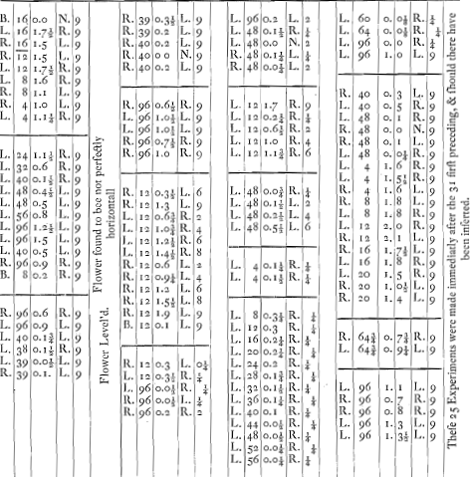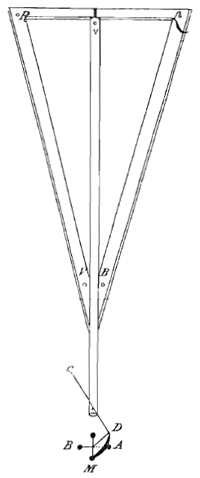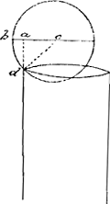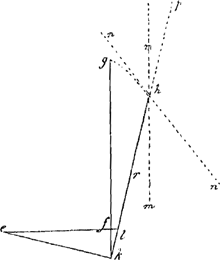Oeuvres complètes. Tome III. Correspondance 1660-1661
(1890)–Christiaan Huygens–
[pagina 323]
| |||||||||||||||||||||||||||||||||
No 889.
| |||||||||||||||||||||||||||||||||
[pagina 324]
| |||||||||||||||||||||||||||||||||
al these, the Experiments I caus'd to bee made before you in the Gallery of this Colledge, you may bee pleased to remember were perform'd (1) taking onely eight graines of ponder for the charge, (2) laying the Engine vppon the flower, and (3) aiming by a thread at M a mark about an inch and three quarters from the mouth of the gunn; (the edge of a knife being put for the mark, the better to discerne the line twas shot in). and they thus succeeded, when the peece was fastened to the flower both at R & L. the Bullet did then so fully hitt the mark, that it was divided by it into two parts whose difference in weight was lesse then ten graines (about the 33d part of the whole Bullet) although the lesser part was a little hollow and that from which the neck of lead was close par'd off. But when hindred from recoiling onely at R the Bullet miss't the mark towards L or A. for the whole bullet lesse then 2 graines excepted, went on that side. And in Like manner when hindred from recoiling at L. the bullet miss'd the mark towards R or B, the whole bullet lesse then two graines excepted, passing the knife on that side thereof. I had the honour to make other Experiments with the same Engine lately at Whitehall, before his Majesty and his Highnesse RoyallGa naar voetnoot2) within the Tilt yard gallery where there is the harth of a Chimney rais'd a little above the flower, about the distance of 13 feet from the opposite wall, against which I caus'd a planck to bee plac'd, and the Engine to be laid first against the middle of the harth that it might not recoile at all, and that part of the board to be mark'd against which t'was level'd knowne by a line strech'd from the breech of the peece vnto the board, directly over the sight and button; and then fire being given (the charge being but eight graines of pouder as before) the bullet did fully hitt the mark. Secondly (the peece charg'd and level'd in the same manner) was laid at the end of the harth next the park so that very little of the Corner R rested against it, & then the bullet miss'd the mark about an inch and a quarter towards the Park or A. the like being done at the other end of the harth, the bullet then miss'd the mark as much the other way. and afterwards, with double that charge, something more, as before I had found it lesse with a smaller charge. since this, (at first designeing onely to experiment the severall distances that the bullet is carried wide off the mark with different charges of pouder,) I made these experiments following. In the first ColumneGa naar voetnoot3) whereof you have the corner stop'd from recoiling, In the second the graines of pouder with which the peece was charg'd. In the third, the distance the bullet was shot wide from the mark in inches, tenths, & parts of tenths. In the fourth, the side on which the bullet was carried. And in the last, the distance of the mark, from the muzzle of the gunn in feet. | |||||||||||||||||||||||||||||||||
[pagina 325]
| |||||||||||||||||||||||||||||||||
 | |||||||||||||||||||||||||||||||||
[pagina 326]
| |||||||||||||||||||||||||||||||||
Whence you may bee pleas'd to observe (1st) that the Recoile of the peece being hinderd onely at R or L. whatsoever be the charge of ye pouder, the bullet still misseth the marke, placed at the mouth of the Gunn, on the same side that the recoile is made, (2dly) that about twelve graines of pouder shouts widest from the marke, at all distances above mentioned, on the same side that the recoile is made. And (3dly) that above 48 graines of pouder shouts wide from the mark, plac'd at 9 foot from the muzzle of the peece, on the contrary side to that on which the recoile is made. The cause of the first I cannot doubt to bee the recoile of the peece (from the force of the pouder) before the bullet bee parted from it. The second is, as I conceive, because with lesse then twelve graines, the peece ceaseth to recoile, before the bullet be parted from it: and with more then twelve graines, the bullet is parted from the peece, before it hath recoiled so farr. A greater power not moveing a greater weight swifter (horizontally) in the same proportion that it doth the lesser. And for the third I have this to offerGa naar einda), viz: Because the mouth of the Gunn is moving sidewards whilest the bullet is goeing out; therefore the mouth of the peece must be contiguous (at least) vnto the bullet on the contrary side to that on which the peece recoiles, sometimes after the separation made on the other side. And therefore the last impulse of the bullet from the force of the pouder, is on that side the peece recoiles. wherefore the bullet must necessarily crosse the Axis of the peece. and that with a greater or lesser angle according to the force of the pouder. And when this angle therefore is greater then the angle of Recoile, then must the Axis of that Cilinder in which the Bullet moves crosse the Axis of the marke, beyond which intersection the mark being plac'd, the bullet must bee carried necessarily wide off the marke on the contrary side to the recoile of the peece. Some other experiments I have also made with another peece (about the same length, but of a bore neere two tenths of an inch lesse,) & orderd in the same manner; and do find that with a small charge the bullet is shott (thence too) wide off the marke on the same side on which the Recoile is made: and with a full charge wide on the contrary side. I caus'd besides two pistoll barrills of about five inches long, to be plac'd vppon carriages with foure wheeles, and loaded with lead that they might not over turne when discharg'd, and both of equall weight; and one iron cilinder of the length of both their bores, and of the same diameter; with a peece of lead of weight equall to it, so that the peece of lead affixed to either of these gunnes (which of them I should please to charge) might equally poise the other with the iron cilinder. And thus indifferently chargeing either with eight graines more or lesse of pouder, and putting the iron cilinder home into both, the peece of lead being affix'd to that which held the pouder, and then both so set vppon the flower, & the pouder fired; I could not thereby discover that the charged peece, or the other, either of them, did certainely recoile more or lesse then the other, they rather seem'd still to be equall. | |||||||||||||||||||||||||||||||||
[pagina 327]
| |||||||||||||||||||||||||||||||||
These few Experiments I have made since, the Barrell being first cut at the muzzel parallell to a verticall plaine passing the line CD.Ga naar eindb)
|
|




